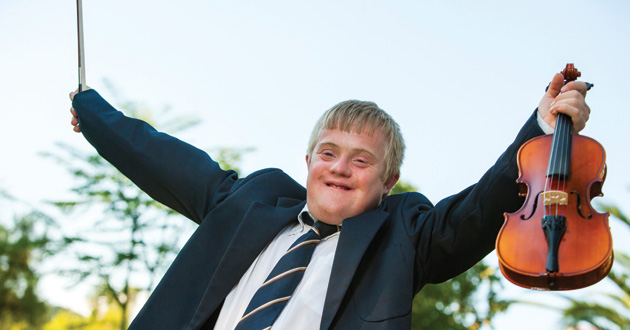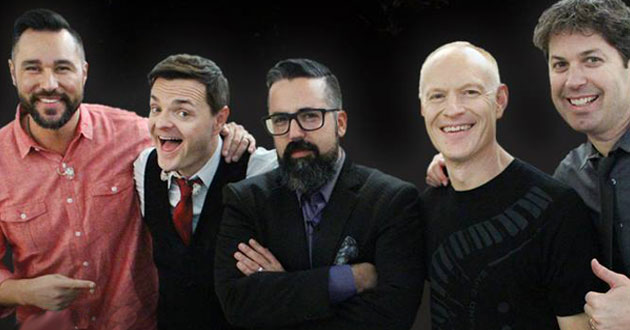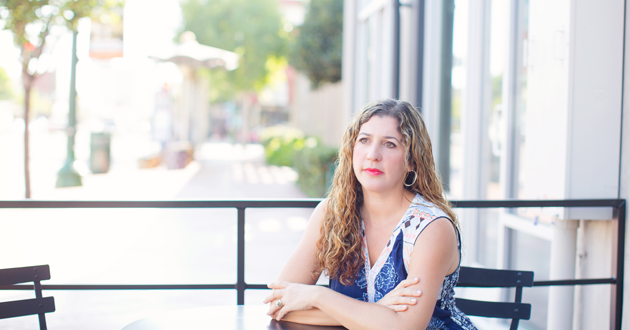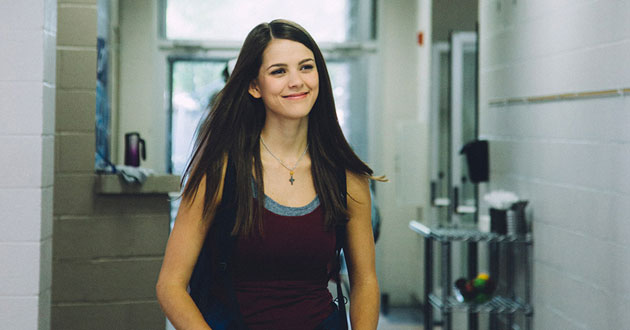Art at the center of life with Down Syndrome

People with different ability levels need the arts, and the arts need them, too.
Katie Blind has sung and danced her entire life, keeping her iPod close by and filled with music. Since she was a little girl watching her mom help produce plays at a local Catholic school, Katie, who has Down syndrome, has dreamed of performing onstage. So, Katie and her mom, Joan Blind, jumped at the opportunity for her to perform in a musical with the Arts Inclusion Company (AIC).
Dianna Swenson founded AIC to provide performance opportunities for people with all ability levels. Swenson has a background in music and dreamed of singing opera professionally. But her dreams altered course when her now 10-year-old son was diagnosed with cerebral palsy.
Many people like Katie come to AIC shy and reserved, afraid of standing out. But along with AIC’s president Meaghan Mozingo and performance coach David Beloff, Swenson helps them overcome the assumption that their different abilities define or limit them. “I hear it from all of them: ‘Nobody gave me a chance,’” Swenson said.
Some consider a Down syndrome diagnosis an inhibitor. Atheist Richard Dawkins infamously tweeted in August that it would be immoral to give birth to a baby with Down syndrome, later explaining that he based his comments on his pragmatic desire to increase happiness and decrease suffering.
“But Mr. Dawkins’s argument is flawed,” wrote Jamie Edgin, an assistant psychology professor at the University of Arizona, and Fabian Fernandez, a research associate at Johns Hopkins University School of Medicine, in The New York Times. “Individuals with Down syndrome can experience more happiness and potential for success than Mr. Dawkins seems to appreciate.”
For many people with Down syndrome, participating in the arts provides those opportunities for success and happiness.
“Art is so central to their lives and a medium by which they share their thoughts, their feelings, their emotions,” said Dr. Brian Skotko, co-director of the Down Syndrome Program at Massachusetts General Hospital. “It’s a mechanism for so many to express themselves.” Skotko’s sister, who has Down syndrome, loves musicals, especially the The Sound of Music starring Julie Andrews. As a little girl, she sang the songs, danced, and dressed up like Maria. “For Kristin, it was a remarkable, emotional experience,” he said.
Two days after Katie, who is 26, and her mother learned about AIC, they arrived at Swenson’s house for what they thought would be a meet-and-greet session. Mozingo showed Katie down a hallway to makeshift audition room. “Do you want me to go in with you?” her mother asked. “Nope, I’ve got it,” Katie said.
In front of the auditioning committee, Katie kept her eyes downcast. “Hi my name’s Katie and I have Down syndrome,” she said. The committeesurprised Katie by asking her to sing something. Listening from the living room, Joan Blind assumed Katie would choose a simple song like “Happy Birthday.” But, Katie chose “This is the Body of Christ,” a song she had learned in her church choir. A week later, Katie learned Swenson selected her to sing Eponine’s theme “On My Own” in Les Miserables School Edition. (AIC was known as Sobotta Productions Musical Theater at the time.)
At AIC, “shadows” work with the performers, guiding them through performances. The shadows stand behind the performers wearing black and modifying their volume to allow the performers to stand out as much as possible. Katie rehearsed twice a week with Swenson as her shadow. But Katie didn’t stop there: For more than two months,her mother came home from teaching to find Katie practicing with her laptop, singing and listening to “On My Own” through headphones.
Besides drama and music, many people with Down syndrome explore dance and fine art with the same dedication. Seven years ago, Colleen Perry, a marriage and family therapist, founded Free 2 Be Me Dance in Los Angeles, an adaptive dance class for children who have Down syndrome. Perry’s instructors work with 30 kids in five different classes teaching them ballet, hip-hop, and soon tap, encouraging artistic expression through routine-free dances. “My goal is to make sure that the students are having fun while engaging discipline and focus while learning sharing and friendship, which you won’t get in a regular dance class,” Perry said. “It’s all about meeting the students where they’re at.”
Many students arrive at their first dance speechless and shy, standing at the bar or staring at themselves in the mirror for the first few classes. But Perry encourages parents not to give up and to keep bringing their children to class. By the fourth class, the students often will relate to something in class like a song and suddenly begin participating. “From then on, I know I have them,” Perry said.
Some people with Down syndrome work to become professional artists. Gateway Arts in Boston provides opportunities for more than 100 people with disabilities, including Down syndrome, to develop their artistic talents and profit from the sale of their work, Skotko said. They gain some independence while demonstrating their capabilities.
Oliver Hellowell’s photography has gained popularity across the world through his Facebook page. According to his mother, Hellowell’s Down syndrome offers him a unique perspective, a trait that has contributed to his popularity. Hellowell now attends college in England and aspires to make photography his profession.
Drama is especially natural for people with Down syndrome because many act throughout their lives, said Gail Williamson, director of Down Syndrome in Arts and Media (DSiAM), a casting liaison for people with Down Syndrome. From a young age, many people with Down syndrome perform social behavior they learn from therapists. But some, like her son Blair, also have an extra bent towardentertaining, Williamson said. Williamson signed up Blair 11-years old to appear in a commercial for the Special Olympics. Blair ran for four hours of film that were eventually cut to a 15-second segment. Williamson had never seen him so focused on anything.
From there, Williamson, who also works for a talent agency, committed to helping her son and others like him act professionally. “My son was on the air, finally,” Williamson said. “And I saw the world changed for my son.” Blair now sees himself as part of a larger community of people who have a variety of abilities.
Meanwhile, audiences are gaining a better understanding of a common disability. After people with Down syndrome began appearing on television shows like “Life Goes On” and “Sesame Street,” the public perception of the disorder began to change. Following those screen appearances, Skotko can trace a “seismic shift in the community’s [perception] of what people with Down Syndrome are capable of.” The public is more aware of their abilities and offering them more opportunities to succeed. “They need opportunities to become flourishing community members like the rest of us,” Skotko said.
Twenty years ago, a variety of misinformation circulated about Down syndrome, making a prenatal diagnosis frightening for parents. But now, thanks to more frequent appearances in major productions, like Lauren Potter’s role as Becky Jackson on Glee, society now sees people with Down syndrome thriving in their communities. Williamson has on file about 400 people interested in acting. A few have autism or cerebral palsy, but most have Down syndrome. Some have landed big roles. “People with Down syndrome are extremely creative,” Williamson said. “[Drama] helps define them and helps them grow.”
After two months of rehearsing, Katie Blind stepped into the spotlight wearing an olive green French Revolution-era costume. “Do your best. Everything’s going to be fine. Just sing your heart out,” her mother had told her. Swenson, clothed in black, stood behind her. Katie focused on the nearly 200-member audience as their voices blended together. By the last line, Katie sang on her own.
In the audience, Joan Blind watched and sobbed, thinking, “That’s my daughter! That’s my daughter!” As the audience erupted with applause, someone shouted “Brava!”
Now, thanks to the opportunity to portray Eponine, Katie’s confidence has soared. Katie dreams of pursuing acting and drama as a career, eventually debuting on Broadway. For now, Katie works as a secretary for the AIC board. And, for the September production Arts Inclusion Presents Broadway in Concert, Katie helped choreograph a dance and sang a duet before an audience of 400 people.
“Playing Eponine turned my life around,” Katie said.
— by Courtney Crandell




